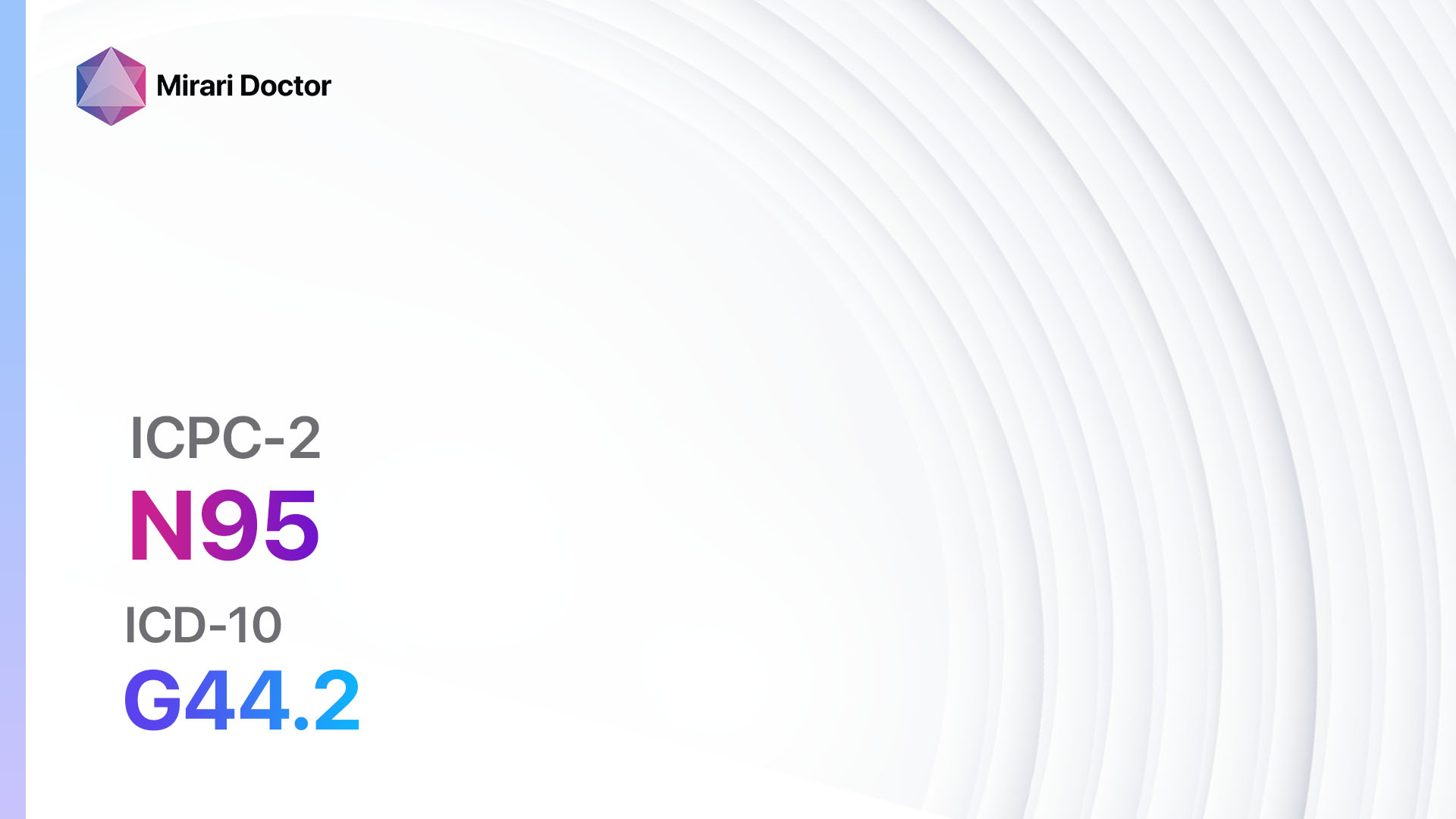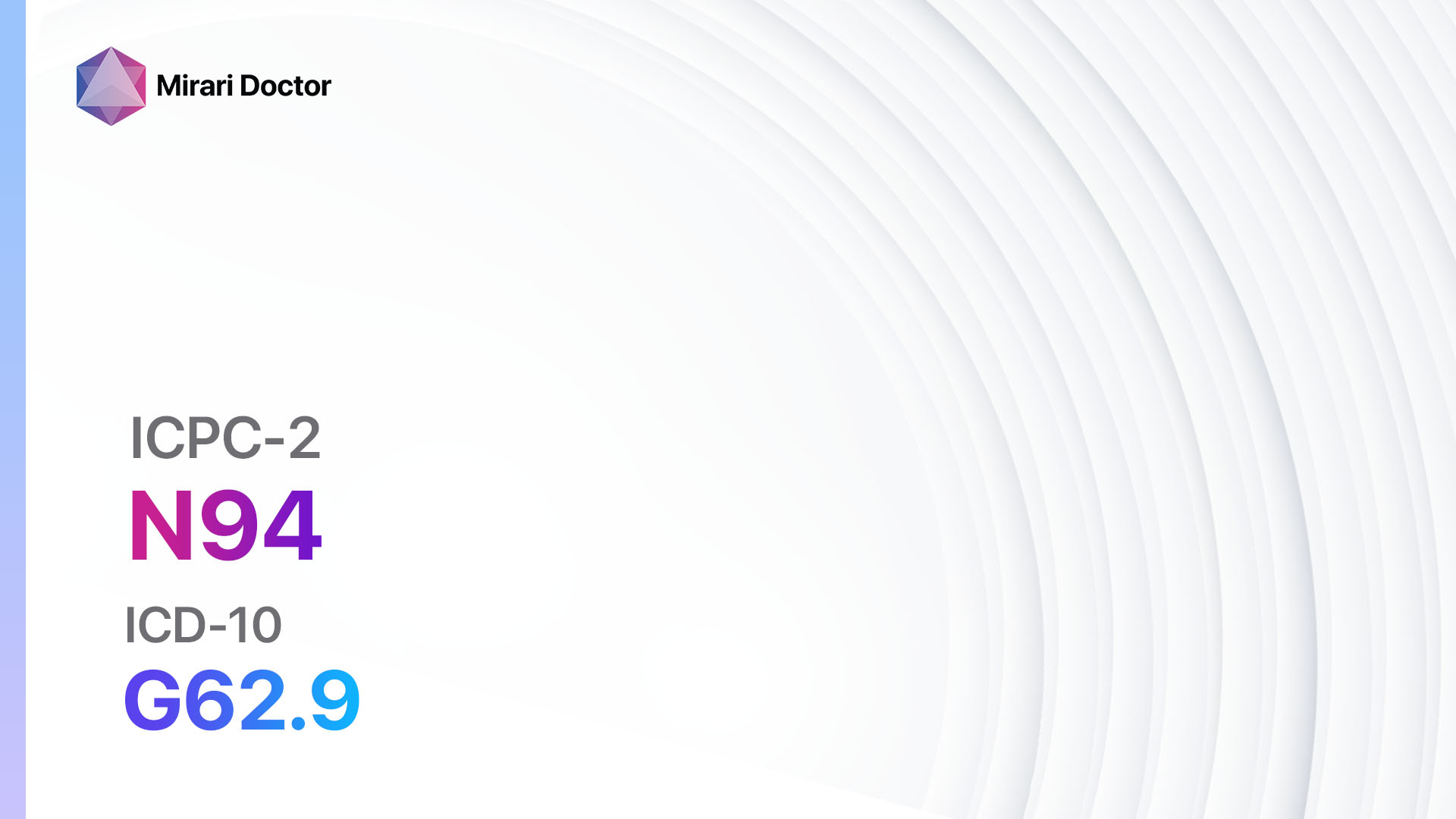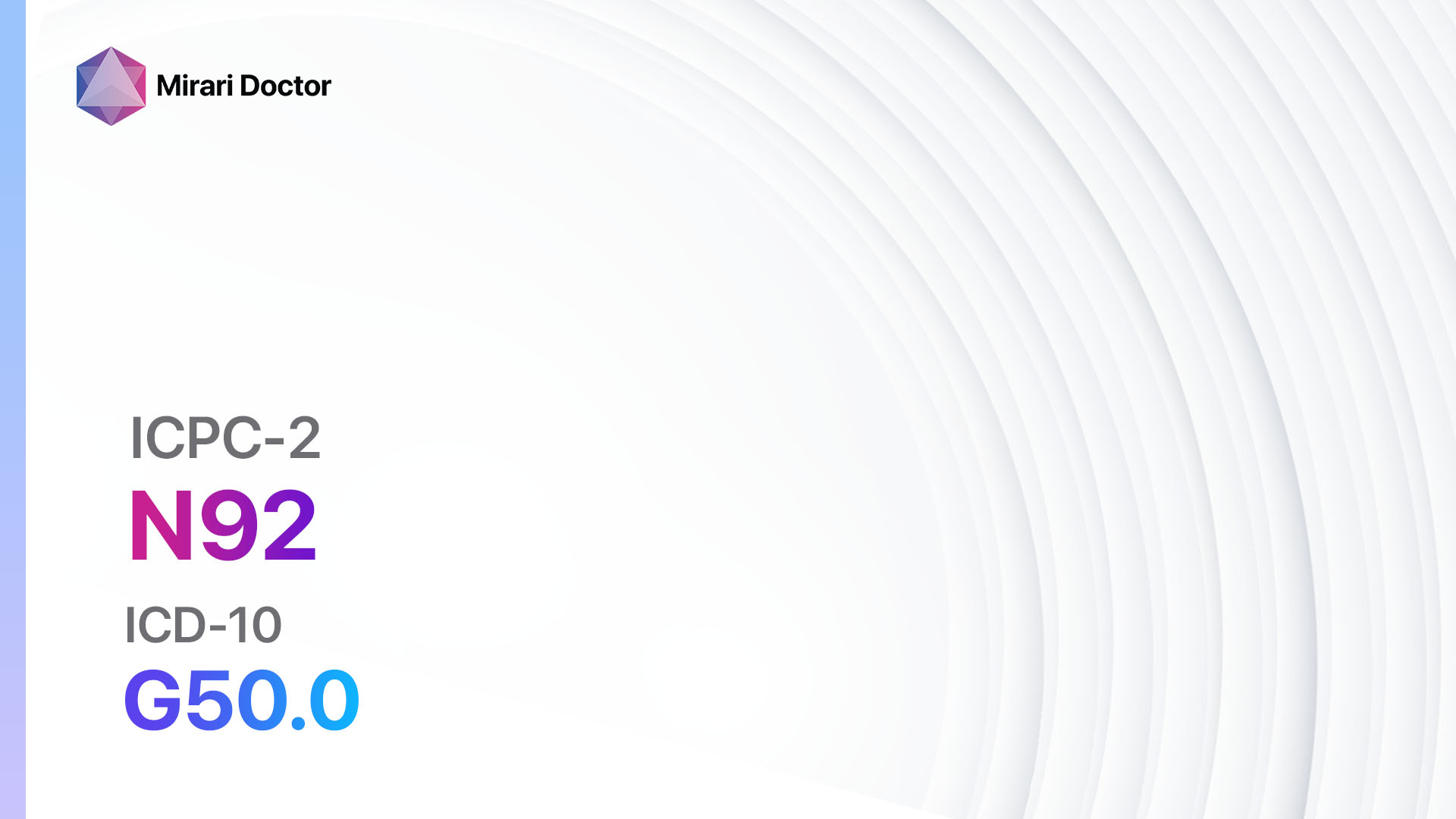
Introduction
Fear of neurological disease other (ICPC-2: N27) refers to the excessive and irrational fear or anxiety related to the possibility of developing a neurological disease. This condition can significantly impact a person’s quality of life and mental well-being[1]. The aim of this guide is to provide healthcare professionals with a comprehensive approach to diagnosing and managing patients with fear of neurological disease other.
Codes
- ICPC-2 Code: N27 Fear of neurological disease other[2]
- ICD-10 Code: Z71.1 Person with feared complaint in whom no diagnosis is made[3]
Symptoms
- Excessive worry or fear about developing a neurological disease
- Preoccupation with physical sensations or changes in the body
- Persistent thoughts or fears of having a neurological disease, despite reassurance from healthcare professionals
- Avoidance of activities or situations that may trigger anxiety about neurological diseases
- Physical symptoms such as headaches, muscle tension, dizziness, or gastrointestinal distress[4]
Causes
- Previous traumatic experience related to neurological disease
- Family history of neurological disease
- Exposure to media or information about neurological diseases
- Generalized anxiety disorder or other anxiety disorders
- Hypochondriasis or illness anxiety disorder[5]
Diagnostic Steps
Medical History
- Gather information about the patient’s personal and family medical history, including any previous diagnoses or experiences related to neurological diseases.
- Assess the patient’s current symptoms and their impact on daily functioning.
- Identify any risk factors or triggers for anxiety related to neurological diseases.
- Evaluate for comorbid mental health conditions, such as generalized anxiety disorder or hypochondriasis[6].
Physical Examination
- Perform a thorough physical examination to assess for any neurological abnormalities or signs of disease.
- Pay attention to any physical symptoms reported by the patient, such as headaches or muscle tension.
- Rule out any physical causes for the patient’s symptoms[7].
Laboratory Tests
- Blood tests: Conduct a complete blood count (CBC), comprehensive metabolic panel (CMP), and thyroid function tests to rule out any underlying medical conditions that may be contributing to the patient’s symptoms.
- Specialized assays: Consider ordering specific laboratory tests based on the patient’s symptoms and medical history, such as tests for autoimmune disorders or vitamin deficiencies[8].
Diagnostic Imaging
- MRI: Consider ordering a brain MRI to rule out any structural abnormalities or lesions that may be causing the patient’s symptoms.
- CT scan: In some cases, a CT scan may be warranted to assess for any abnormalities in the brain or other areas of the body.
- Other imaging modalities: Depending on the patient’s symptoms, consider other imaging studies such as ultrasound or PET scan[9].
Other Tests
- Neurological consultation: If the patient’s symptoms persist or if there are specific concerns about neurological diseases, consider referring the patient to a neurologist for further evaluation.
- Psychological assessment: If anxiety or fear of neurological diseases is significantly impacting the patient’s daily life, consider referring the patient to a mental health professional for a comprehensive psychological assessment[10].
Follow-up and Patient Education
- Schedule regular follow-up appointments to monitor the patient’s symptoms and response to treatment.
- Provide education about anxiety disorders and the role of cognitive-behavioral therapy (CBT) in managing fear of neurological diseases.
- Encourage the patient to engage in self-help strategies, such as relaxation techniques or mindfulness exercises, to manage anxiety symptoms.
- Offer support and reassurance to the patient, emphasizing the importance of seeking help and adhering to the recommended treatment plan.
Possible Interventions
Traditional Interventions
Medications:
Top 5 drugs for fear of neurological disease other:
- Selective serotonin reuptake inhibitors (SSRIs) (e.g., Sertraline, Escitalopram):
- Cost: Generic versions can be $3-$50/month.
- Contraindications: Hypersensitivity to SSRIs, concurrent use of monoamine oxidase inhibitors (MAOIs).
- Side effects: Nausea, headache, sexual dysfunction.
- Severe side effects: Serotonin syndrome, suicidal ideation.
- Drug interactions: MAOIs, other serotonergic drugs.
- Warning: Monitor for worsening of symptoms and suicidality, especially in the initial weeks of treatment.
- Benzodiazepines (e.g., Alprazolam, Diazepam):
- Cost: Generic versions can be $4-$30/month.
- Contraindications: Acute narrow-angle glaucoma, severe respiratory insufficiency.
- Side effects: Sedation, dizziness, cognitive impairment.
- Severe side effects: Respiratory depression, paradoxical reactions.
- Drug interactions: Alcohol, opioids.
- Warning: Risk of dependence and withdrawal symptoms with long-term use.
- Beta-blockers (e.g., Propranolol, Atenolol):
- Cost: Generic versions can be $4-$30/month.
- Contraindications: Severe bradycardia, heart block, uncontrolled heart failure.
- Side effects: Fatigue, dizziness, bradycardia.
- Severe side effects: Bronchospasm, heart block.
- Drug interactions: Calcium channel blockers, insulin.
- Warning: Should not be abruptly stopped.
- Antidepressants (e.g., Amitriptyline, Venlafaxine):
- Cost: Generic versions can be $4-$30/month.
- Contraindications: Hypersensitivity to tricyclic antidepressants (TCAs), recent myocardial infarction.
- Side effects: Dry mouth, constipation, sedation.
- Severe side effects: Cardiac arrhythmias, serotonin syndrome.
- Drug interactions: MAOIs, other serotonergic drugs.
- Warning: Monitor for cardiac toxicity and suicidality.
- Antipsychotics (e.g., Quetiapine, Risperidone):
- Cost: Generic versions can be $4-$30/month.
- Contraindications: Hypersensitivity to antipsychotics, severe CNS depression.
- Side effects: Sedation, weight gain, extrapyramidal symptoms.
- Severe side effects: Neuroleptic malignant syndrome, tardive dyskinesia.
- Drug interactions: Other CNS depressants, anticholinergic drugs.
- Warning: Increased risk of mortality in elderly patients with dementia-related psychosis.
Alternative Drugs:
- Buspirone: An anxiolytic medication that does not cause sedation or dependence.
- Hydroxyzine: An antihistamine with anxiolytic properties.
- Pregabalin: An anticonvulsant medication used for anxiety disorders.
- Gabapentin: Another anticonvulsant medication with anxiolytic effects.
- Mirtazapine: An antidepressant with anxiolytic and sedative properties.
Surgical Procedures:
- There are no surgical procedures specifically indicated for the treatment of fear of neurological disease other.
Alternative Interventions
- Cognitive-behavioral therapy (CBT): A form of psychotherapy that helps individuals identify and change negative thought patterns and behaviors associated with fear of neurological diseases. Cost: $100-$200 per session.
- Mindfulness-based stress reduction (MBSR): A practice that combines mindfulness meditation, body awareness, and yoga to reduce anxiety and improve overall well-being. Cost: $50-$150 per session.
- Support groups: Joining a support group with individuals who have similar fears or experiences can provide emotional support and coping strategies. Cost: Varies depending on the organization or facilitator.
- Relaxation techniques: Teaching patients relaxation techniques, such as deep breathing exercises or progressive muscle relaxation, can help reduce anxiety symptoms. Cost: Free or minimal cost for instructional materials or classes.
- Exposure therapy: Gradual exposure to feared situations or thoughts related to neurological diseases can help desensitize individuals and reduce anxiety. Cost: Typically included as part of CBT sessions.
Lifestyle Interventions
- Regular exercise: Engaging in physical activity can help reduce anxiety and improve overall mental well-being. Cost: Varies depending on the type of exercise (e.g., gym membership, equipment).
- Healthy diet: Encourage patients to follow a balanced diet rich in fruits, vegetables, whole grains, and lean proteins to support overall health and well-being. Cost: Varies depending on individual food choices.
- Stress management techniques: Teach patients stress management techniques, such as meditation, yoga, or journaling, to help cope with anxiety symptoms. Cost: Free or minimal cost for instructional materials or classes.
- Adequate sleep: Emphasize the importance of getting enough sleep to support overall mental and physical health. Cost: Varies depending on individual sleep habits and preferences.
- Avoidance of triggers: Encourage patients to identify and avoid triggers that exacerbate their fear or anxiety about neurological diseases. Cost: None.
It is important to note that the cost ranges provided are approximate and may vary depending on the location and availability of the interventions. Healthcare professionals should consider the individual patient’s preferences, financial situation, and access to resources when recommending interventions.
Mirari Cold Plasma Alternative Intervention
Understanding Mirari Cold Plasma
- Safe and Non-Invasive Treatment: Mirari Cold Plasma is a safe and non-invasive treatment option for various skin conditions. It does not require incisions, minimizing the risk of scarring, bleeding, or tissue damage.
- Efficient Extraction of Foreign Bodies: Mirari Cold Plasma facilitates the removal of foreign bodies from the skin by degrading and dissociating organic matter, allowing easier access and extraction.
- Pain Reduction and Comfort: Mirari Cold Plasma has a local analgesic effect, providing pain relief during the treatment, making it more comfortable for the patient.
- Reduced Risk of Infection: Mirari Cold Plasma has antimicrobial properties, effectively killing bacteria and reducing the risk of infection.
- Accelerated Healing and Minimal Scarring: Mirari Cold Plasma stimulates wound healing and tissue regeneration, reducing healing time and minimizing the formation of scars.
Mirari Cold Plasma Prescription
Video instructions for using Mirari Cold Plasma Device – N27 Fear of neurological disease other (ICD-10:Z71.1)
| Mild | Moderate | Severe |
| Mode setting: 7 (Immunotherapy) Location: 1 (Sacrum) Morning: 15 minutes, Evening: 15 minutes |
Mode setting: 7 (Immunotherapy) Location: 1 (Sacrum) Morning: 30 minutes, Lunch: 30 minutes, Evening: 30 minutes |
Mode setting: 7 (Immunotherapy) Location: 1 (Sacrum) Morning: 30 minutes, Lunch: 30 minutes, Evening: 30 minutes |
| Mode setting: 7 (Immunotherapy) Location: 4 (Heart, Bile & Pancreas) Morning: 15 minutes, Evening: 15 minutes |
Mode setting: 7 (Immunotherapy) Location: 4 (Heart, Bile & Pancreas) Morning: 30 minutes, Lunch: 30 minutes, Evening: 30 minutes |
Mode setting: 7 (Immunotherapy) Location: 4 (Heart, Bile & Pancreas) Morning: 30 minutes, Lunch: 30 minutes, Evening: 30 minutes |
| Mode setting: 7 (Immunotherapy) Location: 6 (Throat, Lymphatic & Thyroid) Morning: 15 minutes, Evening: 15 minutes |
Mode setting: 7 (Immunotherapy) Location: 6 (Throat, Lymphatic & Thyroid) Morning: 30 minutes, Lunch: 30 minutes, Evening: 30 minutes |
Mode setting: 7 (Immunotherapy) Location: 6 (Throat, Lymphatic & Thyroid) Morning: 30 minutes, Lunch: 30 minutes, Evening: 30 minutes |
| Mode setting: 7 (Immunotherapy) Location: 7 (Neuro system & ENT) Morning: 15 minutes, Evening: 15 minutes |
Mode setting: 7 (Immunotherapy) Location: 7 (Neuro system & ENT) Morning: 30 minutes, Lunch: 30 minutes, Evening: 30 minutes |
Mode setting: 7 (Immunotherapy) Location: 7 (Neuro system & ENT) Morning: 30 minutes, Lunch: 30 minutes, Evening: 30 minutes |
| Total Morning: 60 minutes approx. $10 USD, Evening: 60 minutes approx. $10 USD |
Total Morning: 120 minutes approx. $20 USD, Lunch: 120 minutes approx. $20 USD, Evening: 120 minutes approx. $20 USD, |
Total Morning: 120 minutes approx. $20 USD, Lunch: 120 minutes approx. $20 USD, Evening: 120 minutes approx. $20 USD, |
| Usual treatment for 7-60 days approx. $140 USD – $1200 USD | Usual treatment for 6-8 weeks approx. $2,520 USD – $3,360 USD |
Usual treatment for 3-6 months approx. $5,400 USD – $10,800 USD
|
 |
|
Use the Mirari Cold Plasma device to treat Fear of neurological disease other effectively.
WARNING: MIRARI COLD PLASMA IS DESIGNED FOR THE HUMAN BODY WITHOUT ANY ARTIFICIAL OR THIRD PARTY PRODUCTS. USE OF OTHER PRODUCTS IN COMBINATION WITH MIRARI COLD PLASMA MAY CAUSE UNPREDICTABLE EFFECTS, HARM OR INJURY. PLEASE CONSULT A MEDICAL PROFESSIONAL BEFORE COMBINING ANY OTHER PRODUCTS WITH USE OF MIRARI.
Step 1: Cleanse the Skin
- Start by cleaning the affected area of the skin with a gentle cleanser or mild soap and water. Gently pat the area dry with a clean towel.
Step 2: Prepare the Mirari Cold Plasma device
- Ensure that the Mirari Cold Plasma device is fully charged or has fresh batteries as per the manufacturer’s instructions. Make sure the device is clean and in good working condition.
- Switch on the Mirari device using the power button or by following the specific instructions provided with the device.
- Some Mirari devices may have adjustable settings for intensity or treatment duration. Follow the manufacturer’s instructions to select the appropriate settings based on your needs and the recommended guidelines.
Step 3: Apply the Device
- Place the Mirari device in direct contact with the affected area of the skin. Gently glide or hold the device over the skin surface, ensuring even coverage of the area experiencing.
- Slowly move the Mirari device in a circular motion or follow a specific pattern as indicated in the user manual. This helps ensure thorough treatment coverage.
Step 4: Monitor and Assess:
- Keep track of your progress and evaluate the effectiveness of the Mirari device in managing your Fear of neurological disease other. If you have any concerns or notice any adverse reactions, consult with your health care professional.
Note
This guide is for informational purposes only and should not replace the advice of a medical professional. Always consult with your healthcare provider or a qualified medical professional for personal advice, diagnosis, or treatment. Do not solely rely on the information presented here for decisions about your health. Use of this information is at your own risk. The authors of this guide, nor any associated entities or platforms, are not responsible for any potential adverse effects or outcomes based on the content.
Mirari Cold Plasma System Disclaimer
- Purpose: The Mirari Cold Plasma System is a Class 2 medical device designed for use by trained healthcare professionals. It is registered for use in Thailand and Vietnam. It is not intended for use outside of these locations.
- Informational Use: The content and information provided with the device are for educational and informational purposes only. They are not a substitute for professional medical advice or care.
- Variable Outcomes: While the device is approved for specific uses, individual outcomes can differ. We do not assert or guarantee specific medical outcomes.
- Consultation: Prior to utilizing the device or making decisions based on its content, it is essential to consult with a Certified Mirari Tele-Therapist and your medical healthcare provider regarding specific protocols.
- Liability: By using this device, users are acknowledging and accepting all potential risks. Neither the manufacturer nor the distributor will be held accountable for any adverse reactions, injuries, or damages stemming from its use.
- Geographical Availability: This device has received approval for designated purposes by the Thai and Vietnam FDA. As of now, outside of Thailand and Vietnam, the Mirari Cold Plasma System is not available for purchase or use.
References
- American Psychiatric Association. (2013). Diagnostic and statistical manual of mental disorders (5th ed.). Arlington, VA: American Psychiatric Publishing.
- World Health Organization. (2021). International Classification of Primary Care, Second edition (ICPC-2). Retrieved from https://www.who.int/standards/classifications/other-classifications/international-classification-of-primary-care
- World Health Organization. (2019). International Statistical Classification of Diseases and Related Health Problems (11th ed.). https://icd.who.int/
- Stein, D. J., Craske, M. G., Friedman, M. J., & Phillips, K. A. (2011). Meta-structure issues for the DSM-5: How do anxiety disorders, obsessive-compulsive and related disorders, post-traumatic disorders, and dissociative disorders fit together? Current Psychiatry Reports, 13(4), 248-250.
- Asmundson, G. J., Abramowitz, J. S., Richter, A. A., & Whedon, M. (2010). Health anxiety: Current perspectives and future directions. Current Psychiatry Reports, 12(4), 306-312.
- Tyrer, P., Cooper, S., Crawford, M., Dupont, S., Green, J., Murphy, D., … & Tyrer, H. (2011). Prevalence of health anxiety problems in medical clinics. Journal of Psychosomatic Research, 71(6), 392-394.
- Olatunji, B. O., Deacon, B. J., & Abramowitz, J. S. (2009). Is hypochondriasis an anxiety disorder? The British Journal of Psychiatry, 194(6), 481-482.
- Sunderland, M., Newby, J. M., & Andrews, G. (2013). Health anxiety in Australia: Prevalence, comorbidity, disability and service use. The British Journal of Psychiatry, 202(1), 56-61.
- Diagnostic and Statistical Manual of Mental Disorders: DSM-5. (2013). American Psychiatric Association.
- Taylor, S., & Asmundson, G. J. G. (2004). Treating health anxiety: A cognitive-behavioral approach. Guilford Press.
Related articles
Made in USA




























